All new posts going forward will appear at that site, but you can still enjoy 7 years of archives here.
Help Support This Blog
Monday, May 9, 2016
We've Moved To A New Site!
Bobby Owsinski's Music Production Blog can now be found at:
All new posts going forward will appear at that site, but you can still enjoy 7 years of archives here.
All new posts going forward will appear at that site, but you can still enjoy 7 years of archives here.
Friday, May 6, 2016
Kansas "Carry On My Wayward Son" Isolated Guitar Tracks
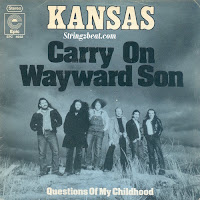 "Carry On My Wayward Son" by Kansas has been burned into our minds thanks to 40 years of constant airplay, so it's fun to listen inside the song to what's really going on. Here's its isolated guitar tracks, and you'll be surprised with at least some of them.
"Carry On My Wayward Son" by Kansas has been burned into our minds thanks to 40 years of constant airplay, so it's fun to listen inside the song to what's really going on. Here's its isolated guitar tracks, and you'll be surprised with at least some of them.As with just about any hit, there's a lot more that's going on than you ever thought. Here are some things to listen for (it starts at 0:17).
1. The main intro as well as the bridge lead line is closely doubled with an extra guitar playing accents an octave higher.
2. An acoustic guitar enters on the second half of the first verse at 1:26 playing a very nice counterpoint melody. This comes back in for the entire second verse as well. You usually don't here this clearly on the final mix.
3. There's a clean (sounds like it's direct) arpeggiated electric guitar with a nice room sound that enters during the chorus. Again, it's not something that you hear well on the final mix.
4. The lead guitar harmonies at the end of the intro and the end of the song are very cool.
It's interesting to hear how well all the parts were executed in the song, which was not exactly standard production technique for 1975 when the song was recorded. You can tell that the band was well-rehearsed and played well together thanks to the hundreds of gigs they played together beforehand.
Thursday, May 5, 2016
Avid Restructures To Please Wall Street
 A few months ago Avid proudly put out a press release about how they just hired 250 new employees to staff new facilities in the Philippines, Taiwan and Poland, and how they would save $68 million as a result. Oh, and by the way, that was at the expense of closing down offices and downsizing its staff in the U.S.
A few months ago Avid proudly put out a press release about how they just hired 250 new employees to staff new facilities in the Philippines, Taiwan and Poland, and how they would save $68 million as a result. Oh, and by the way, that was at the expense of closing down offices and downsizing its staff in the U.S.Now the latest Avid press release touts how Taipei City is the "new home of hardware design," the new "global support center" in the Philippines will be open 24 hours a day, and the new R&D center in Szczecin Poland includes "veteran staff for engineering, customer care and professional services."
It's also opening a new Boca Raton, Florida office for a "consolidated administrative support group, leveraging a strong work force to improve efficiency and productivity."
Does this sound like a company that really cares about you, the user?
Does it sound like a great idea to can all the people in the U.S. responsible for the development of the hardware and software for the simple reason of finding cheaper ones off-shore?
How about taking the support for its complex products and moving it all to the Philippines?
These moves have nothing to do with the user, of course, since it's all about looking good for Wall Street, which is something that Avid desperately needs. It's stock is near an all-time low, down nearly 65% in the last year alone.
That's the problem with public companies in general. For the most part, the execs get caught up in a game of "pleasing the Street" rather than looking out for its customers. In short, it's stockholders become its customers.
Avid's CFO and executive vice-president John Frederick has announced that he's stepping down after the upcoming May 10th earnings call, which means that the outlook probably won't be too shiny and happy, and the restructuring is a band-aid (and a poor one) at best on the hope that a few analysts will slap a "Buy" recommendation on it.
Those of us who use Avid audio products look at these moves with a great deal of skepticism, and at the same time keep an eye out for the next alternative.
Pro Tools and the other audio-related products are only part of the Avid's product profile, but the company performance gives it's users reason for great concern for the company's, and their future.
(Photo: Maverx via Wikipedia)
Labels:
Avid,
business restructuring,
Pro Tools,
stock price
Wednesday, May 4, 2016
How To Time Your Reverb Decay To The Track
 |
| Reverb Front To Back |
One of the questions I get a lot is, "How do you time your reverb to the track?"
There's a step by step tutorial in my Audio Mixing Bootcamp book that I've excepted from the Adding Reverb chapter of the book below. By the way, there's also a video version of the book available on Lynda.com.
––––––––––––––––––––––––––––––––
"Like with other aspects to mixing, the use of reverb is frequently either overlooked or misunderstood. Reverb is added to a track to create width and depth, but also to dress up an otherwise boring sound. The real secret is how much to use and how to adjust its various parameters.
Before we get into adding and adjusting the reverb in your mix, let’s look at some of the reasons to add reverb first
When you get right down to it, there are four reasons to add reverb.
1. To make the recorded track sound like it’s in a specific acoustic environment. Many times a track is recorded in an acoustic space that doesn’t fit the song or the final vision of the mix. You may record in a small dead room but want it to sound like it was in a large studio, a small reflective drum room, or a live and reflective church. Reverb will take you to each of those environments and many more.
2. To add some personality and excitement to a recorded sound. Picture reverb as makeup on a model. She may look rather plain or even only mildly attractive until the makeup makes her gorgeous by covering her blemishes, highlighting her eyes, and accentuating her lips and cheekbones. Reverb does the same thing with you tracks in many cases. It can make the blemishes less noticeable, change the texture of the sound itself, and highlight it in a new way.
3. To make a track sound bigger or wider than it really is. Anything that’s recorded in stereo automatically sounds bigger and wider than something recorded in mono, because the natural ambience of the recording environment is captured. In order to keep the track count and data storage requirements down, most instrument or vocal recordings are done in mono. As a result, the space has to be added artificially by reverb. Usually, reverb that has a short decay time (less than one second) will make a track sound bigger.
4. To move a track further back in the mix. While panning takes you from left to right in the stereo spectrum, reverb will take you from front to rear (see the figure on the left). An easy way to understand how this works is to picture a band on stage. If you want the singer to sound like he’s in front of the drum kit, you would add some reverb to the kit. If you wanted the horn section to sound like it was placed behind the kit, you’d had more reverb. If you wanted the singer to sound like he’s in between the drums and the horns, you’d leave the drums dry and add a touch of reverb to the vocal, but less than the horns.
If we were going to get more sophisticated with this kind of layering, we’d use different reverbs for each of the instruments and tailor the parameters to best fit the sound we’re going after.
Timing A Reverb To The Track
One of the secrets of hit-making engineers is that they time the reverb to the track. That means timing both the pre-delay and the decay so it breathes with the pulse of the track. Here’s how it’s done.
The decay of a reverb is timed to the track by triggering it off of a snare hit and adjusting the decay parameter so that the decay just dies by the next snare hit. The idea is to make the decay “breathe” with the track.
Exercise Pod - Timing Reverb Decay
Before you begin any of the exercises in this chapter, be sure to have two reverbs with the sends and returns already set up. Set one reverb to “Room” (we’ll call it Reverb #1) and the other to “Hall” (Reverb #2). Refer to your DAW or console manual on how to do this.
E8.1: Solo the snare drum and the reverb returns (or put them into Solo Safe - refer to you DAW or console manual on how to do this). Be sure that the Dry/Wet control is set to 100% wet, and the return levels are set at about -10.
A) Raise the level of the send to the Room reverb until the reverb can be clearly heard. Does the snare sound distant? Does it sound bigger than before?
B) Adjust the Decay parameter until the reverb dies out before the next snare hit of the song. Does the snare sound clearer?
C) Mute the send to the Room reverb and raise the level to the Hall reverb. Does the snare sound distant? Does it sound bigger than before? Does it sound bigger than the Room reverb?
D) Adjust the Decay parameter until the reverb dies out before the next snare hit of the song. Does the snare sound clearer? Does it sound bigger?
E) Adjust the Decay parameter until the reverb dies out before the 2nd next snare hit after the initial hit. Does the snare sound clearer? Does it sound bigger?"
––––––––––––––––––––––––––––––––
You can read more from The Audio Mixing Bootcamp and my other books on the excerpt section of bobbyowsinski.com.
Labels:
Audio Mixing Bootcamp,
book excerpt,
reverb,
reverb decay,
reverb timing
Tuesday, May 3, 2016
Behringer Companies To Cut Staff
 Through the years Behringer has developed from a small company that copied successful products then pioneered making them China, to a powerhouse global brand.
Through the years Behringer has developed from a small company that copied successful products then pioneered making them China, to a powerhouse global brand.In fact, the company has grown into a holding company known as MUSIC, that controls not only Behringer, but well-respected brands like Midas, Klark Teknik, Turbosound and the TC Group (which itself controlled TC Electronic, Tannoy, Lab Gruppen and Lake).
The company has grown so powerful that it even has what amounts to its own manufacturing city in China.
One of the problem with so called "roll-ups" of companies is that as much of the work as possible is consolidated under one roof, and as a result, sooner or later, redundant staff is let go, and that's exactly what's about to happen now.
The first to feel the burn is Tannoy, where 70 staff members at its manufacturing plant in Scotland (which had been there for 35 years) and its office in Cambridge will be eliminated. That great English imprint will now be made in Zhongshan, China instead.
MUSIC is now one of the largest, if not the largest, conglomerates in the musical instrument/audio business, for better or worse. On one hand, the prices of its products (even the high end products by Midas) are very reasonable considering the performance. On the other, there's a group of talented craftsman that will soon be looking for work while Chinese robots take their places.
Here's a video that shows Behringer City in China.
Labels:
Behringer,
Behringer City,
Midas,
MUSIC Group,
Tannoy,
TC Electronic
Monday, May 2, 2016
Rapper/Entrepreneur Manafest On My Latest Inner Circle Podcast
 My guest this week is musician, rapper and entrepreneur Chris Greenwood, who goes by the stage name of Manafest.
My guest this week is musician, rapper and entrepreneur Chris Greenwood, who goes by the stage name of Manafest.Chris has released 8 critically acclaimed studio albums that have either won or been nominated for a host of GMA and Juno awards, and he's self-financed his last 3 projects with crowdfunding campaigns.
Chris has also written a book and created a number of online music business courses designed to help up and coming musicians learn the ropes, based on his experiences.
One of the best parts of our conversation was about the limitations and advantages of performing to iPod backing tracks, and the transition to using a live band.
In the intro I'll take a look at cover song recordings being removed from popular online sites like iTunes and Spotify, and a study that describes how your music matches your personality (or vice versa).
Remember that you can find the podcast at BobbyOInnerCircle.com, either on iTunes, Stitcher and now on Mixcloud and Google Play.
New Music Gear Monday: Digitech Whammy Ricochet Pedal
 Every songs wants a signature sound and as a result, we often spend days at a time in the studio searching for just the right one to put a stamp on a recording. The one cool thing is about some of the latest electronic plugins and pedals is that it's getting easier and easier to dial up something that used to take long effects chains to get. A good example of simplicity, small package and great sound can be found in Digitech's new Whammy Ricochet guitar pedal.
Every songs wants a signature sound and as a result, we often spend days at a time in the studio searching for just the right one to put a stamp on a recording. The one cool thing is about some of the latest electronic plugins and pedals is that it's getting easier and easier to dial up something that used to take long effects chains to get. A good example of simplicity, small package and great sound can be found in Digitech's new Whammy Ricochet guitar pedal.The pedal can be used to provide whammy bar-like effects for those with guitars with stop tailpieces (or keyboards for that matter), or can be used to change the pitch as much as an octave up or down.
The Whammy Ricochet is based around the same technology as Digitech's Whammy Pitch Shifter, only this comes in a mini-pedal package and uses a momentary switch instead of a full pedal.
Seven pitches are available - 2nd, 4th, 5th, 7th, Octave, Double Octave, and Octave+Dry - up or down, while shift and return knobs control the rate at which the pitch rises and falls. A series of trajectory LEDs provide a visual indication of pitch-shift direction and rate.
A true bypass latching footswitch mode is also available to maintain the selected pitch, and players have a choice of polyphonic Chords mode (from the Whammy DT) and glitchy Classic (from the original Whammy) tracking.
Digitech's Whammy Ricochet is available in May and June for a special introductory price of $187.44. Check out the example video below.
Friday, April 29, 2016
Stevie Wonder "Superstition" Isolated Clavinets
 How many times have you heard a cover band play Stevie Wonder's seminal "Superstition" and think, "That doesn't sound like the record."
How many times have you heard a cover band play Stevie Wonder's seminal "Superstition" and think, "That doesn't sound like the record."One of the reasons why is because there's more than one clavinet on the track, a fact that's usually overlooked by the band. In fact, according to Bob Margouleff (who recorded and co-produced the song - hear him talk about working with Stevie on my Inner Circle Podcast episode #78) there are actually 4 clavs on the track, and in today's video you can hear them clearly.
1. The clav track on the left during the verse is the signature line that everyone knows.
2. The clav track on the right plays counterpoint to the signature track, and is actually key to the sound of the record (and the part that no one ever plays).
3. During the B-section there are two new clav sounds that replace the verse clavs, one on each side, that are much softer sounding.
4. Listen for the amplifier noise (no directs used here) on the intro of the track, and Stevie singing in the background during the breaks.
Labels:
Bob Margouleff,
clavinet,
isolated tracks,
Stevie Wonder,
video
Thursday, April 28, 2016
Glyn Johns On Recording Who's Next
 I've always been a huge Who fan and just as big a fan of producer Glyn Johns work. This video is from an interview at the Rock and Roll Hall of Fame in Cleveland, November 19, 2012, and focuses on the recording of the seminal Who's Next.
I've always been a huge Who fan and just as big a fan of producer Glyn Johns work. This video is from an interview at the Rock and Roll Hall of Fame in Cleveland, November 19, 2012, and focuses on the recording of the seminal Who's Next.What's especially interesting is how many of the main parts in several songs were actually lifted from Pete Townshend's demos, and the band played to the parts when tracking. Also, some interesting tidbits about Keith Moon's drum tuning.
Labels:
glyn johns,
interview,
Pete Townshend,
The Who,
video,
who's next
Wednesday, April 27, 2016
Overcoming The Self-Production Blues
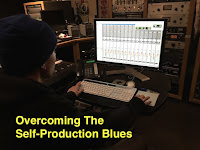 One of the things about having your own studio is that you can do a project at your own pace. The problem there is that some artists never know when to declare a production finished and they end up with "the project that never ends," literally spending years on it.
One of the things about having your own studio is that you can do a project at your own pace. The problem there is that some artists never know when to declare a production finished and they end up with "the project that never ends," literally spending years on it.Here's an excerpt from the upcoming 2nd edition of my Music Producer's Handbook that addresses the issue.
"Self-Production is simultaneously one of the most difficult things to do in music and at the same time perhaps one of the easiest. Every artist hears what their music should sound like in their head (that’s the easy part), but it’s sometimes difficult to get it to actually sound that way when it comes to real-life recording.
For many singer songwriters, that can lead the artist to overwork a song until it’s limp like a dishrag, or overproduce it until it has so many layers that it sounds like there’s a 30 piece band backing you up. Indeed, it’s difficult to get it to sound somewhere in between where your project is both exciting and vital, and still meets your vision.
For many artists, working in a vacuum can sometimes lead to new discoveries since you’re not beholden to any previously learned “rules,” or it can lead to frustration from not being able to get the sound that you want and not having anyone to turn to for help.
Let’s look at some ways to stay out of the self-production rut.
Overcoming The Self-Production Blues
One of the biggest problems for an artist is creating in circles. This means that the artist has so many good ideas that the production is never finished. As soon as a version is complete, the artist thinks, “Maybe the middle 8 should have a ska feel.” Then after that’s recorded he thinks, “Maybe the entire song should have a ska feel.” Before you know it there are versions in 6/8, speed metal and reggae (and maybe more), with each one sounding different, but not necessarily better.
If this is what's happening to you, there are two words to keep in mind to help you out of your rut.
Instinct - Usually, the very first inspiration is the right one, especially if you’ve gone through more than a couple of different versions. You’ve got to repress the urge to keep changing things and learn to follow your initial instinct. That doesn’t mean you shouldn’t tweak or perfect what you’re doing; it means that you shouldn’t make a completely opposite turn in a direction that goes against your initial inspiration.
The exception to this is if you think it might be cool to have multiple different versions of the song available so you can give the alternate versions to your core fans as an exclusive gift, use them as a promotional vehicle, or because it’s been specifically requested by a music supervisor for a television show or movie. In any of those cases, a wholesale change in direction can actually be particularly useful and even profitable.
Deadline - One of the biggest problems with producing yourself is the fact that your project is usually open-ended time-wise. As a result, you end up with the “project that wouldn’t end” that keeps going for years (no exaggeration here).
The surest way to keep that from happening and to actually accomplish something is to set a deadline for the project’s completion. Many people do their best work on deadlines because they don’t have a chance to second guess themselves.
The final product may not be 100% of what you want, but remember that it seldom ever is, even with all the time in the world available to finish the project. Save yourself some heartache and impose a deadline on yourself so you can finish that project and get it out the door where it can do you some good."
You can read more from The Music Producer's Handbook and my other books on the excerpt section of bobbyowsinski.com.
Tuesday, April 26, 2016
The Abbey Road ADT Story
 The Beatles, and John Lennon in particular, loved to double track vocals but hated the act of doing it. Not only that, back in the 4 and 8 track days, the doubled vocal would take up a track that could have been used for another element of the production.
The Beatles, and John Lennon in particular, loved to double track vocals but hated the act of doing it. Not only that, back in the 4 and 8 track days, the doubled vocal would take up a track that could have been used for another element of the production.That's why Abbey Road chief engineer, technical director, and later studio manager Ken Townsend came up with an ingenious way of simulating a double by using a couple of tape machines that's still tough to duplicate even today (although Waves now has a nice simulation). He called the effect ADT or Artificial Double Tracking.
Here's Ken describing how the effect worked.
Labels:
Abbey Road studios,
ADT,
artificial double tracking,
John Lennon,
Ken Townsend,
the beatles,
video
Monday, April 25, 2016
New Music Gear Monday: SSL System T Console
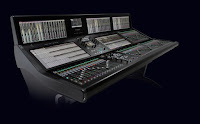 NAB was pretty cool this year but one of the products that jumped out was the new Solid State Logic System T console. While this isn't of direct interest to most of you in terms of a purchase, it's worth knowing about since it's stunning in both its looks and capabilities.
NAB was pretty cool this year but one of the products that jumped out was the new Solid State Logic System T console. While this isn't of direct interest to most of you in terms of a purchase, it's worth knowing about since it's stunning in both its looks and capabilities.The SSL System T was designed from the ground up specifically to handle large-scale productions in a fully networked broadcast environment. Up to 3 consoles or control surfaces can be placed on the network to access a fully redundant pair of processor engines so there's never any downtime for the system. The routing and I/O is based on the new Dante HC connectivity, so any Dante-driven I/O stagebox with work with the console.
The Tempest processor engine is capable of real-time, 64-bit CPU-based, floating point mixing and processing. Each processor engine can handle up to 3072 inputs and outputs and provides 800 fully configurable processing paths, up to 192 mix buses, 800 EQs, 800 dynamics and 400 delays!
Paths, processing and routing can be dynamically allocated in real time without interrupting audio, which is a unique feature in a broadcast console.
System T’s also features a control surface that incorporates multi-gesture touch screen technology, which seems to take a page out of the Slate Raven playbook.
The SSL System T is so new that it hasn't been priced yet, but you can be pretty sure that you won't be seeing it in a recording studio near you anytime soon. That said, I wouldn't be surprised to see a more music-oriented spinoff of the System T in the near future.
Labels:
Dante HC,
New Music Gear Monday,
SSL,
SSL System T
Friday, April 22, 2016
The Who "Baba O'Riley" Isolated Tracks
 The Who's "Baba O'Riley" is one of the most played tracks in the entire band's catalog, to the point were just about every fan (and non-fan's alike) know each note and part by heart.
The Who's "Baba O'Riley" is one of the most played tracks in the entire band's catalog, to the point were just about every fan (and non-fan's alike) know each note and part by heart.That's why today's isolated track is so cool. It strips away the arpeggiated synthesizer and, in some parts, the piano, to give you a clear listen as to what's going on deep inside the mix. Here are some things to listen for:
1. The reverb on the vocal is pretty short, unlike many Who mixes. It's also delayed so the vocal stands out a bit more.
2. The drums are in stereo, but have an unusual balance, with the snare and most of the kit leaning right and the ride and a crash leaning left. On the tom fill at 1:33 you can hear the rack tom on the left as well. Keith Moon also rarely plays the hat during the song, instead bashing the cymbals throughout, something that a producer would no doubt change today.
3. The big guitar power chords in the verse (0:51) are doubled and maybe even tripled, which you don't notice in the full mix.
4. The outro starting at 3:11 sounds much different without the violin. You definitely get to appreciate Moon's prowess with his dynamics and machine gun snare roll.
Labels:
isolated tracks,
Keith Moon,
reverb,
The Who,
video
Thursday, April 21, 2016
Pressing A Vinyl Record In 60 Seconds
 Vinyl is all the rage again, but most people don't understand just how chemical and mechanical the process really is. In this very quick video, you'll see the electroplating process that goes into making the various stages of master, mother and stampers. That's the messy part of the business, and the one that everyone hopes will die soon thanks to the new laser master process that's in development.
Vinyl is all the rage again, but most people don't understand just how chemical and mechanical the process really is. In this very quick video, you'll see the electroplating process that goes into making the various stages of master, mother and stampers. That's the messy part of the business, and the one that everyone hopes will die soon thanks to the new laser master process that's in development.From there you see the record being pressed and packaged, all pretty much the way it was done way back in the 50s. The video was done at the Vinyl Factory in the UK and compresses the entire manufacturing process into just 60 seconds.
Labels:
record pressing,
video,
Vinyl Factory,
vinyl records
Wednesday, April 20, 2016
The 6 Trouble Frequencies
 Whenever an engineer has trouble dialing in the EQ on a track, chances are its because of one or more of the 6 trouble frequency areas.
Whenever an engineer has trouble dialing in the EQ on a track, chances are its because of one or more of the 6 trouble frequency areas.These are areas where too much or too little can cause your track to either stick out like a sore thumb, or disappear into the mix completely. Let's take a look.
- 200Hz (Mud) - Too much can cause the track or the mix to sound muddy or boomy, while not enough of it can make it sound thin. It's a fine line, but many times mixers err on the side of too much and end up with a track that's too thick that clutters up the mix.
- 300 to 500Hz (Boxy) - Too much of this frequency area results in the dreaded "boxiness" sound, or if you're listening to a floor tom or kick, the "beach ball" effect. It's also a spot that some less expensive microphones (especially dynamics) tend to emphasize, which is why many mixers almost automatically cut a a few dB of this area out of the kick drum during the mix.
- 800Hz (Walmart) - Too much in this area results in what's sometimes known as the "Walmart" sound, meaning that it sounds like a cheap stereo purchased in a department store. Try it for yourself - get a cheap pair of computer speakers and you'll find that 800Hz is what you'll mostly hear. Obviously, too much of this frequency range is not a good thing.
- 1k to 1.5kHz (Nasal) - This is the nasal range of the frequency spectrum and, as the name suggests, too much results in a vocalist that sounds like she's singing through her nose. Once again this is primarily a microphone problem in that it's poorly matched to the vocalist, but notching a bit out during the mix can fix it.
- 4kHz to 6kHz (Presence) - This frequency range is frequently underutilized during the mix, resulting in a track that lacks definition. Without it, things tend to sound dull, but too much can make the track sound thin or, in the case of a vocal, sibilant.
- 10kHz+ (Air) - Another widely overlooked frequency band, this provides clarity and adds a certain "realness" to the track. Many vintage mics have a lot of the air frequencies, which is why we prize them for their sound. The Maag Audio EQ4P has a special "Air Band" designed to provide those frequencies with a minimum of phase shift, but you can dial it in other equalizers as well.
You can read more from The Mixing Engineer's Handbook and my other books on the excerpt section of bobbyowsinski.com.
Labels:
6 trouble frequencies,
air band,
Maag Audio,
vocals
Tuesday, April 19, 2016
Music Genres And Your Personality
 Does the type of music we listen to provide clues to our personality?
Does the type of music we listen to provide clues to our personality?Empirically you'd say yes, but there's a study that confirms that the genre of music we prefer goes a long way in outlining what we're like in our daily lives.
For better or worse, this is what the study found.
- Blues fans have high self-esteem, are creative, outgoing, gentle and at ease
- Jazz fans have high self-esteem, are creative, outgoing and at ease
- Classical music fans have high self-esteem, are creative, introvert and at ease
- Rap fans have high self-esteem and are outgoing
- Opera fans have high self-esteem, are creative and gentle
- Country and western fans are hardworking and outgoing
- Reggae fans have high self-esteem, are creative, not hardworking, outgoing, gentle and at ease
- Dance fans are creative and outgoing but not gentle
- Indie fans have low self-esteem, are creative, not hard working, and not gentle
- Bollywood fans are creative and outgoing
- Rock/heavy metal fans have low self-esteem, are creative, not hard-working, not outgoing, gentle, and at ease
- Chart pop fans have high self-esteem, are hardworking, outgoing and gentle, but are not creative and not at ease
- Soul fans have high self-esteem, are creative, outgoing, gentle, and at ease
Agree or disagree? Does one of these categories define your personality, or is it way off?
Monday, April 18, 2016
Producer/Engineer John Kurzweg On My Latest Inner Circle Podcast
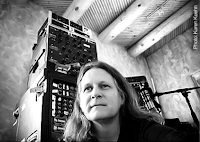 In an episode that you won't want to miss, Producer/engineer/musician John Kurzweg is my guest on this week's Inner Circle podcast.
In an episode that you won't want to miss, Producer/engineer/musician John Kurzweg is my guest on this week's Inner Circle podcast.If you've listened to rock radio, you're certainly familiar with John's work, as he's produced 12 #1 singles and another 8 top 10's for bands like Creed, Puddle of Mud, Godsmack and many others.
John's led a really interesting musical life, from an early guitar teacher telling him to give up, to a career as a solo artist, to engineering hits in his living room, there's a lot to learn from this great conversation.
In the intro I'll take a look at the ramifications of YouTube's major label licenses expiring, to the recent financial woes of Gibson Guitars.
New Music Gear Monday: Eventide Tverb Room Reverb Plugin
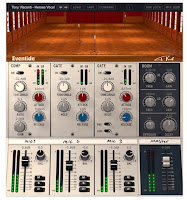 We all love great room sounds and one of the most famous rooms ever recorded was on David Bowie's "Heroes" by Tony Visconti. Visconti set up three microphones in the hall of Berlin’s Hansa Studios; the first for Bowie to sing directly into, a second positioned about 15 feet away and the third further back in the hall. Visconti placed gates on the second and third microphones set to open as Bowie sang louder and louder.
We all love great room sounds and one of the most famous rooms ever recorded was on David Bowie's "Heroes" by Tony Visconti. Visconti set up three microphones in the hall of Berlin’s Hansa Studios; the first for Bowie to sing directly into, a second positioned about 15 feet away and the third further back in the hall. Visconti placed gates on the second and third microphones set to open as Bowie sang louder and louder.This same sound can now be duplicated with the new Eventide Tverb, which consists of three completely independent reverbs with compression, selectable polar patterns on microphone 1 and adjustable gates on microphones 2 and 3.
What's more, the original effect was mono due to track limitations, but Tverb provides it in true stereo. The use of stereo microphones enhances the effect and DAW automation can be used to program the microphones to wander around the hall as the track plays.
Tverb consists of a variety of parameters, like 2 moveable microphones to adjust reverb size and tone, a custom Eventide reverb algorithm with EQ, diffusion, and decay control, 2 linkable post-reverb gate modules with control of when the gates close, the speed at which they close and the length of time they are forced to stay open. Signal inversion buttons are also available to remove (or create) phase cancellation, and a Mix Lock allows for scrolling through presets or settings while keeping the wet/dry mix constant.
The user interface is based on a "console" that was inspired by the one used in the session and is complete with Visconti’s "grease pencil" labelling, and provides post-reverb channel processing for each individual mic and the master. The room mixer module alters the sound of the room itself with control over decay, diffusion and frequency attenuation.
The Eventide Tverb is normally priced at $249 but currently has an introductory price of $149. A fully functioning 30 day demo version is also available. The plugin is available in AAX, VST and AU versions that work on most DAWs.
Friday, April 15, 2016
Toto "Rosanna" Isolated Drums, Keys And Horns
 The band Toto has some of the most acclaimed studio musicians as members, which is why it's always a pleasure to listen inside one of their songs. Today we'll take a listen to the isolated drums, keyboards and horns from the Grammy-winning song "Rosanna." This one's a real treat! Here's what to listen for:
The band Toto has some of the most acclaimed studio musicians as members, which is why it's always a pleasure to listen inside one of their songs. Today we'll take a listen to the isolated drums, keyboards and horns from the Grammy-winning song "Rosanna." This one's a real treat! Here's what to listen for:1. The late great Jeff Porcaro is on drums playing a version of the half-time "Purdie shuffle" feel. You can hear why he was one of the most in-demand session drummers ever, with rock solid time and a feel that pushes the track along perfectly. His drums sound great, with just a touch of reverb for ambience.
2. The arrangement is based around David Paich's (another great session player) piano, which starts in a middle register and moves up an octave for the B section of the song, then back down for the C section and chorus. It also has a nice stereo spread with the left hand panned to about 9 o'clock and the right at around 1:30.
3. Listen to the way Steve Porcaro's synthesizer strategically weaves in and out of the song. It's mostly on an organ patch, but you can hear the patch morph into a string patch at the end of the chorus.
4. In the solo section around 3:20, percussion is added that gives that section some movement.
5. Check out the horn section on the turnaround to each chorus and playing a fill line in the chorus. It's a section of 2 saxes, 2 trumpets and a trombone that are doubled and panned in stereo.
6. The outro jam is a real treat.
Labels:
David Paich,
isolated tracks,
Jeff Porcaro,
Toto,
video
Thursday, April 14, 2016
Was "Stairway To Heaven" A Rip Off?
 In what could become one of the more entertaining court battles in music history, Led Zeppelin is being sued for stealing parts of "Stairway To Heaven" from a song by the 60s band Spirit called "Taurus" more than 45 years after the song was written. The estate of Spirit guitarist and "Taurus" songwriter Randy California filed the lawsuit, which is going to trial on May 10th.
In what could become one of the more entertaining court battles in music history, Led Zeppelin is being sued for stealing parts of "Stairway To Heaven" from a song by the 60s band Spirit called "Taurus" more than 45 years after the song was written. The estate of Spirit guitarist and "Taurus" songwriter Randy California filed the lawsuit, which is going to trial on May 10th.All this stems from the fact that Zep opened for Spirit several times during their first tour of the United States during which Spirit performed "Taurus" as part of their set. OK, we get that, but why wait 40+ years to sue?
If you listen to the Spirit song below, you'll hear some vague similarities to the intro of "Stairway," but it's of a rather generic guitar pattern and nothing like the song's melody. That said, after last year's "Blurred Lines" plagiarism lawsuit won by the estate of Marvin Gaye, suits like this are now leaning more in favor of the plaintiff than ever before.
It's been estimated that "Stairway" has made the Zeps $540 million over the years, and the California estate is obviously hoping for at least a reasonable piece of that, but songwriters Jimmy Page and Robert Plant (who are the only Zeps named in the suit) obviously have deep pockets and are willing to fight as necessary.
So songwriters beware, there's nothing new under the sun given the 12 note scale that western musicians use, so you're probably copying a previous song without even knowing it. And today, that's enough to get you sued.
Go to 0:45 on the video below to hear what's considered to be the similarities between songs.
(photo: Jim Summaria via Wikipedia)
Labels:
copyright infringement,
Jimmy Page,
lawsuit,
Led Zeppelin,
Randy California,
Robert Plant,
Spirit,
Stairway to Heaven
Wednesday, April 13, 2016
So You Want To Buy A Cheap Microphone
 |
| Can you spot the fake? |
In many ways we're in the golden age of audio gear. On the whole, inexpensive audio gear (under $500) sounds better than ever and is a much better value than even a decade ago and way better than 20 years ago. The same can be said for mics, as there is a large variety of cheap mics that provide much higher performance for the price than we could have imagined back in the 70s and 80s.
That said, there are some pitfalls to be aware of before you buy. Here's an excerpt from The Recording Engineer's Handbook 3rd edition that covers the potential downside of inexpensive mics.
"One of the more interesting recent developments in microphones is the availability of some extremely inexpensive condenser and ribbon microphones in the sub-$500 category (in some cases even less than $100). While you’ll never confuse these with a vintage U 47 or C 12, they do sometimes provide an astonishing level of performance at a price point that we could only dream about a few short years ago. That said, there are some things to be aware of before you make that purchase.
Quality Control’s The Thing
Mics in this category have the same thing in common; they’re either entirely made or all their parts are made in China, and to some degree, mostly in the same factory. Some are made to the specifications of the importer (and therefore cost more) and some are just plain off-the-shelf. Regardless of how they’re made and to what spec, the biggest issue from that point is how much quality control (or QC, also sometimes known as quality assurance) is involved before the product finds its way into your studio.
Some mics are completely manufactured at the factory and receive a quick QC just to make sure they’re working and these are the least expensive mics available. Others receive another level of QC to get them within a rather wide quality tolerance level, so they cost a little more. Others are QC’d locally by the distributor with only the best ones offered for sale, and these cost still more. Finally, some mics have only their parts manufactured in China, with final assembly and QC done locally, and of course, these have the highest price in the category.
You Can Never Be Sure Of The Sound
One of the byproducts of the rather loose tolerances due to the different levels of QC is the fact that the sound can vary greatly between mics of the same model and manufacturer. The more QC (and high the resulting price), the less difference you’ll find, but you still might have to go through a number of them to find one with some magic. This doesn’t happen with the more traditional name brands that cost a lot more, but what you’re buying (besides better components in most cases) is a high assurance that your mic is going to sound as good as any other of the same model from that manufacturer. In other words, the differences between mics are generally a lot smaller as the price rises.
The Weakness
There are two points that contribute to a mic sounding good or bad, and that’s the capsule and the electronics (this can be said of all mics, really). The tighter the tolerances and better QC on the capsule, the better the mic will sound and the closer each mic will sound to another of the same model.
The electronics is another point entirely in that a bad design can cause distortion at high SPL levels and limit the frequency response, or simply change the sound enough to make it less than desirable. The component tolerances these days are a lot closer than in the past, so that doesn’t enter into the equation as much when it comes to having a bearing on the sound. In some cases, you can have what could be a inexpensive great mic that’s limited by poorly designed electronics. You can find articles all over the Web on how to modify many of these mics, some that make more of a difference to the final sound than others. If you choose to try doing a mod on a mic yourself, be sure that your soldering chops are really good since there’s generally so little space that a small mistake can render your mic useless."
You can read additional excerpts from The Recording Engineer's Handbook or my other books on the excerpts section of bobbyowsinski.com.
Tuesday, April 12, 2016
Is Gibson In Financial Trouble?
 There are signs that Gibson's move to diversify isn't working out as planned. Moody's Investor Service has downgraded Gibson Brands (formerly Gibson Guitar Corporation) credit to junk status, and according to reports, the company has put up two of its Nashville warehouses for sale as a result.
There are signs that Gibson's move to diversify isn't working out as planned. Moody's Investor Service has downgraded Gibson Brands (formerly Gibson Guitar Corporation) credit to junk status, and according to reports, the company has put up two of its Nashville warehouses for sale as a result.Moody's gave 3 reasons for the downgrade:
1. "Weak operating results" as a result of a poor reception to the company's 2015 guitar line.
2. Frequent management changes in its finance department.
3. The company's recent move into consumer electronics and the associated risks of doing so.
Starting in 2012, Gibson began to buy consumer electronics company like Onkyo and Teac. Prior to that, it had purchased the Stanton Group, which included Cerwin-Vega, Stanton DJ and KRK. In 2014 the company acquired Woox, a Singapore-based company specializing in consumer electronics accessories.
According to an article by Ted Green, this most recent acquisition left the company over-leveraged and the company is facing $100 million in payments over the next 22 months. Speculation is that the company doesn't have the cash to make these payments, which is the reason for the sale of the two Nashville warehouse properties.
Gibson has done a number of business maneuvers in the last few years that have been head-scratchers, but the fact of the matter is that the company is trying to grow by expanding beyond MI. The problem there is that unless you know the other markets well, it's very difficult to play in the land of the really deep pockets. Let's see what happens over the next few months.
Labels:
consumer electronics,
Gibson,
Gibson Brands,
junk bonds,
Moody's,
Onkyo,
Stanton Group,
Teac
Monday, April 11, 2016
New Music Gear Monday: Radial BT-Pro Bluetooth Direct Box
 Radial Engineering makes a grand variety of useful direct boxes, and just about the time you think they've thought of everything, they come up with something new. One of the company's more unique DIs is the new BT-Pro, a unique Bluetooth direct box that converts a wireless audio signal into an analog stereo balanced line.
Radial Engineering makes a grand variety of useful direct boxes, and just about the time you think they've thought of everything, they come up with something new. One of the company's more unique DIs is the new BT-Pro, a unique Bluetooth direct box that converts a wireless audio signal into an analog stereo balanced line.This allows you to connect your phone or iPad directly to a PA or recording device without having to resort to an assortment of patch cables.
The BT-Pro is built to be bullet-proof just like all other Radial DIs, as it's made from 14 gauge steel with an l-beam frame that hangs over the controls to keep them out of harms way.
It uses the latest Bluetooth wireless A2DP interface over 2.0 EDR (Enhanced Data Rate) for higher speed transmission to deliver optimal audio quality, with reception out to 60 feet. This standard employs a 16-bit wireless compressed format with the actual bit rate determined by the transmission source material.
There are two balanced XLR outputs that feature isolation transformers to eliminate any buzz or hum, an output control, plus a built-in headphone amp for troubleshooting using a standard 3.5mm mini TRS output connector.
There's also a stereo-to-mono switch that sums the input for dual-mono operation, as well as two side-mounted switches that insert the isolation transformers into the signal path. This is supplemented by a ground lift switch for the XLRs to help further eliminate any ground loops. The unit is powered via a USB connector.
The Radial Engineering BT-Pro sells for a reasonable $229.99, and like most Radial gear, will probably last a lifetime. Find out more on the dedicated BT-Pro web page.
Labels:
BT-Pro,
direct box,
New Music Gear Monday,
Radial Engineering
Friday, April 8, 2016
The Beatles "Drive My Car" Isolated Bass
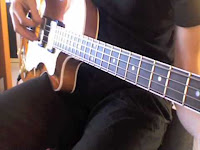 Paul McCartney is one of the most influential bass players ever, and it's always very cool to be able to listen to his isolated bass tracks. Today we'll take a listen to The Beatles "Drive My Car" from the Rubber Soul album. Here's what to listen for.
Paul McCartney is one of the most influential bass players ever, and it's always very cool to be able to listen to his isolated bass tracks. Today we'll take a listen to The Beatles "Drive My Car" from the Rubber Soul album. Here's what to listen for.1. Listen to the pickup notes at the end of the bass phrase during the verse. He doesn't play it all the time, but it makes for a very funky bass line when he does.
2. Paul plays the bass line of the chorus differently, sometimes even within the same chorus. Sometimes each note is held out, and other times it's very staccato.
3. The bass track is far from perfect, with a major clam at 1:57 and some minor ones along the way. That said, it took another 10 years or so until production techniques really focused on each individual part and how it interacted with the other elements of the song, as well as how consistently each part was played.
In other words, it's a great track for its time, but would have been fixed or replayed in today's production environment.
----------------------------------
You should follow me on Twitter and Facebook for daily news and updates on production and the music business.
Don't forget to check out my Music 3.0 blog for tips and tricks on navigating social media and the new music business.
Labels:
isolated bass,
Paul McCartney,
the beatles,
video
Thursday, April 7, 2016
New Speech Enhancement Technology Let's You Hear Over The Crowd
 We've all been at an airport or train station, or even a concert, where there's an announcement and we can't quite make out what it was over the noise. Those days may soon be over thanks to a new speech enhancement technology from Fraunhofer called ADAPT DRC.
We've all been at an airport or train station, or even a concert, where there's an announcement and we can't quite make out what it was over the noise. Those days may soon be over thanks to a new speech enhancement technology from Fraunhofer called ADAPT DRC.Researchers at the Project Group Hearing, Speech and Audio Technology at Fraunhofer Institute for Digital Media Technology developed the ADAPT DRC software in an effort to improve any type of electronic communication, but venues with congregations of people were the primary target.
What happens is that microphones are strategically placed around a venue to constantly monitor the ambient noise level. When the noise gets too loud, the software boosts the speech frequencies instead of the overall volume of the speakers. This keeps the speakers from distorting, making it even more difficult to understand the announcement.
Instead ADAPT DRC strategically boosts the consonant sounds like "P," "T," and "K," which are often spoken quickly, but are really the key to understanding what is being said.
The software also takes into account the parts of the speech signal that are naturally at a different volume and uses an intelligent algorithm called Dynamic Range Compression (the DRC in ADAPT DRC) to boost the intelligibility. This technology is already used on many cell phones.
I always marvel at how crappy some announcement sound systems can be, considering the technology that's available today. Let's hope that ADAPT DRC works as sited and is widely adapted so we don't miss that next flight to AES.
(Photo credit: Dornum72 via Wikipedia)
Labels:
ADAPT DRC,
Fraunhofer,
speech algorithm,
speech enhancement
Wednesday, April 6, 2016
11 Steps To Better Overdubs
 Many times the ear candy of an overdub session can really make or break a song, but sometimes it's not easy to create to capture that magic.
Many times the ear candy of an overdub session can really make or break a song, but sometimes it's not easy to create to capture that magic.Here's an excerpt from the upcoming second edition of my Music Producer's Handbook that can act as either an outline or as a reminder to check a number of critical points both before and during your overdub session.
"1. Do you have a list of overdub priorities? Do you know which overdubs absolutely must get done and which ones are less important? A list will keep you on track budget-wise and time-wise.
2. Can you record in the control room? Most players prefer to record in the control room because they like to hear what you’re hearing and they like the immediacy of the communication.
3. Are there too many people in the control room or studio? The fewer the people, the fewer the distractions. It’s best to keep all friends, associates, and hangers-on out of the studio when you’re working to keep the distractions to a minimum.
4. Did you move the vocal or the instrument into the big part of the studio? All instruments sound best when there’s space for the sound to develop, so move the vocal or the instrument into the big part of the studio for overdubs (after you’ve done any basic track fixes). You can cut down on any unwanted reflections from the room by placing baffles around the mic and player.
5. When doubling, are you trying to do something a little different on each track? Using a different mic, mic preamp, room, singer, or distance from the mic will all help to make the sound get bigger.
6. When doubling or adding more guitars, do you have a variety of instruments and amplifiers available? Two guitars (a Les Paul and a Strat, for instance) and two amplifiers (a Fender and a Marshall is the classic combination) combined with different pickup choices will allow a multitude of guitar tracks to live in the mix together more effectively.
7. Are you making it sound better, not just different? Changes aren’t always for the better. Is there a big difference between what you just recorded and the original part? Does the new part make everyone in the studio go crazy in a good way?
8. Would it be better to try recording the part tomorrow? You’d be surprised how much more you can accomplish when you’re fresh.
9. Do you have the studio talkback mic on? Can you hear the musicians in the studio at all times between takes? If they’re talking to you but you can’t hear them, they’ll feel isolated.
10. Do you always have the control room talkback mic on? Can the musicians hear you at all times in between takes? Periods of silence can be a mood killer.
11. Does a musician want to play his or her part again? If a player feels strongly about playing it over, he probably can do it better. Be sure to keep the last recorded part before recording again."
You can read more from The Music Producer's Handbook and my other books on the excerpt section of bobbyowsinski.com.
Labels:
book excerpt,
music producers handbook,
overdubs
Tuesday, April 5, 2016
Kevin Killen On Mixing With Limited Processing
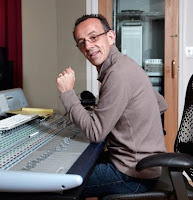 Kevin Killen is a great engineer with a host of big time credits (U2, Elvis Costello and Peter Gabriel, for instance) and he's been much in demand as a mixer for a long time. When I wrote the first edition of The Mixing Engineer's Handbook, Kevin was one of the mixers I most wanted to interview, and that interview is one of the best in the book.
Kevin Killen is a great engineer with a host of big time credits (U2, Elvis Costello and Peter Gabriel, for instance) and he's been much in demand as a mixer for a long time. When I wrote the first edition of The Mixing Engineer's Handbook, Kevin was one of the mixers I most wanted to interview, and that interview is one of the best in the book.Here's a great video where Kevin explains how he mixes in the box, and how he applies his processing mostly to subgroups rather individual tracks, as well as the way he adds effects.
Labels:
Kevin Killen,
mixing,
Universal Audio,
video
Monday, April 4, 2016
Producer/Engineer Ken Caillat On My Latest Inner Circle Podcast
 Regardless of your age, you've no doubt heard much of Rumors over the years, the great Fleetwood Mac album from 70s. The songs from that record are still heard everywhere today, and a tribute to the contributions to the project (as well as 3 others by Fleetwood Mac) by my guest on this week's podcast - producer/engineer Ken Caillat.
Regardless of your age, you've no doubt heard much of Rumors over the years, the great Fleetwood Mac album from 70s. The songs from that record are still heard everywhere today, and a tribute to the contributions to the project (as well as 3 others by Fleetwood Mac) by my guest on this week's podcast - producer/engineer Ken Caillat.Ken has a long list superstar credits including The Beach Boys, Frank Sinatra, Pat Benetar, Herbie Hancock and many more. He's also the father and producer of singer/songwriter Colby Caillat.
During the interview we talk about how he first connected with Fleetwood Mac, the recording of Rumors (including an interesting tape loop story), as well as what it's like to produce your daughter.
In the intro I'll take a look at how EDM has peaked and its popularity is slowing, and the implications of SoundCloud's new Go paid tier.
Labels:
Bobby Owsinski's Inner Circle Podcast,
BobbyOinnercircle.com,
EDM,
Fleetwood Mac,
Inner Circle podcast,
Ken Caillat,
SoundCloud Go
New Music Gear Monday: Audio Technica ATM230 Tom Microphone
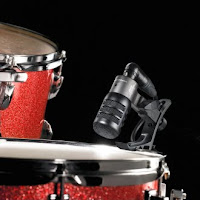 It doesn't matter what microphone you like to use on toms, because chances are that it's going to pick up a lot of the cymbals as well. This is pretty typical because most of the mics that end up on toms have a cardioid pattern. The problem is that there aren't too many true hypercardioid mics available to limit that cymbal bleed, especially in a package that fits conveniently out of the way of both drummer and cymbals. That was before the recent introduction of the Audio Technica's ATM230 purpose-built tom mic though.
It doesn't matter what microphone you like to use on toms, because chances are that it's going to pick up a lot of the cymbals as well. This is pretty typical because most of the mics that end up on toms have a cardioid pattern. The problem is that there aren't too many true hypercardioid mics available to limit that cymbal bleed, especially in a package that fits conveniently out of the way of both drummer and cymbals. That was before the recent introduction of the Audio Technica's ATM230 purpose-built tom mic though.The new ATM230 is that elusive hypercardioid mic built into a small package, with a response that's tailored to capture both the stick sound and body of all rack and floor toms. What's even better is the fact that it comes with an integral isolated tom mount, so you don't need an expensive 3rd party mount or mic stand.
It's a dynamic mic so it's inherently rugged, and is made of metal so it can stand up to stick hits (I hate it when my expensive condenser mics take a hit), and it's reasonably priced to boot.
The Audio Technica ATM230 has a street price of $139 and also comes in a three pack for $349.
Labels:
ATM230,
Audio Technica,
New Music Gear Monday,
tom microphone,
video
Friday, April 1, 2016
Recording A Band With Just One Stereo Mic
 Usually I post an isolated track on Friday, but this is something that's pretty close. In this video, engineer John Cuniberti uses a single stereo AEA R88 stereo ribbon mic to record the band San Geronimo - no overdubs, no additional mics.
Usually I post an isolated track on Friday, but this is something that's pretty close. In this video, engineer John Cuniberti uses a single stereo AEA R88 stereo ribbon mic to record the band San Geronimo - no overdubs, no additional mics.
For those of you who don't know, John was the guy who came up with the idea of reamping, a technique and box that's used every day in studios around the world.
The recording just goes to show how good it can actually sound when the band is placed at the right distances, know how to control their volume, and all come up with a good performance at the same time. Of course, having a great acoustic environment really helps as well (25th Street Recording in Oakland).
Labels:
1 mic recording,
25th Street Recording,
AEA R88,
John Cuniberti,
San Geronimo,
stereo mic,
video
Subscribe to:
Comments (Atom)

